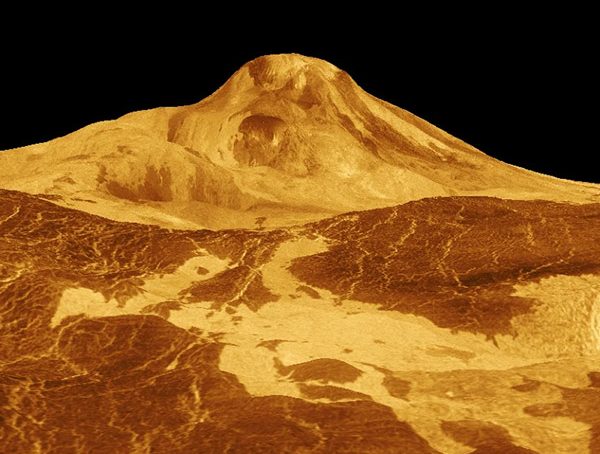
Scientists have found some of the strongest evidence yet that there is volcanic activity on Venus. Because the planet is a close neighbour to Earth and originally had water on its surface, one big question has been why its landscape is hellish while Earth’s is habitable.
Learning more about its volcanic activity could help explain its evolution – and Earth’s.
Scientists have known that Venus is covered in volcanoes, but whether or not any of them is still active has been long debated. Now, researchers have discovered that at least one of them probably is, by examining radar images of the planet’s surface collected by NASA’s Magellan spacecraft between 1990 and 1992.
They determined that a volcanic vent located in Venus’s Atla Regio area, which contains two of the planet’s largest volcanoes, changed shape between two images taken eight months apart, suggesting an eruption or flow of magma beneath the vent. The scientists reported their findings on Wednesday March 15 in Science and presented them at the Lunar and Planetary Science Conference in the Woodlands, Texas, on the same day.
This is a “striking find”, says Darby Dyar, an astronomer at Mount Holyoke University in South Hadley, Massachusetts. It brings the space-research community one step closer to figuring out how Venus works, adds Dyar, who is also deputy principal investigator of the VERITAS mission to Venus, which is being overseen by NASA’s Jet Propulsion Laboratory (JPL) in Pasadena, California, and aims to map the planet’s surface sometime after 2030.
“The whole subject of whether there is active volcanism on the surface of Venus suffers from a lack of data,” she adds.
Gathering evidence that the planet is volcanically active wasn’t easy. Venus’s thick atmosphere – 100 times the mass of Earth’s – and high temperatures – 450 ºC – make it difficult for rovers and other probes to explore the surface. So far, the most reliable data scientists have collected have come from the Magellan spacecraft.
Robert Herrick, a geophysicist at the University of Alaska Fairbanks, and Scott Hensley, a radar scientist at JPL who is also part of the VERITAS team, analysed full-resolution radar images captured by Magellan of areas with suspected volcanic activity.
The challenge was that Magellan imaged the planet in three different cycles over its 24-month mission. During each cycle, it pointed its radar at a different angle to Venus’s surface. For scientists to look for changes on the surface over time, they had to superimpose the images at various angles and find overlaps in the terrain to line them up.
Herrick compares the problem to flying from multiple directions through the Grand Canyon in Arizona and then trying to map its surface while looking at opposite canyon walls. “Trying to find the same things in those images gets a little more challenging,” he says.
The low resolution of the Magellan images added another layer of complexity. “You’re looking at the surface, where a football field is a single pixel,” he adds.
This worries Scott King, a geophysicist at Virginia Tech University in Blacksburg who studies Venus. He questions whether the images are strong enough evidence to convince sceptics that Venus is volcanically active. “Proof is in the eye of the beholder,” he says.
Herrick and Hensley acknowledge this limitation in their data. But they also say they are not aware of any equivalent event on Earth that could cause the changes they observed without volcanic activity, though they cannot rule out the possibility that something else might have been responsible.
King doesn’t find it hard to believe that the planet has volcanic activity. He hopes, though, that upcoming missions to Venus, including VERITAS, will provide the data needed to convince everyone.
VERITAS, however, has been delayed — so King may be waiting longer than originally thought. NASA had planned to launch the mission in 2028, but the agency had to reallocate funding to address the delay of Psyche, another mission that will study a metal-rich asteroid orbiting the Sun between Mars and Jupiter. NASA currently does not have funds planned in the coming years for VERITAS, and if it restores funding, the mission would launch no earlier than 2031.
Launching VERITAS after 2030 could cause problems for other missions, Dyar says. Ideally, the topographic data collected by VERITAS would have provided NASA’s DAVINCI and the European Space Agency’s EnVision with information to help them better target areas they’re planning to explore. DAVINCI, set to launch in 2029, aims to drop a probe into Venus’s atmosphere, and EnVision, set to launch in the early 2030s, is meant to take high-resolution radar images of the planet’s surface.
Studying Venus could not only help researchers understand more about how Earth works, but it could help them learn more about exoplanets beyond the Solar System. “We’re discovering hundreds, thousands of exoplanets,” Dyar says. And many of those seem to be Venus-like, she adds.
Many space missions have been targeting Mars recently, even though overall, Venus is much more Earth-like than the red planet. Herrick hopes the new findings will motivate people to turn their eyes towards Venus and launch VERITAS on time. “Venus is truly Earth’s sibling,” he says.
- A Nature report











